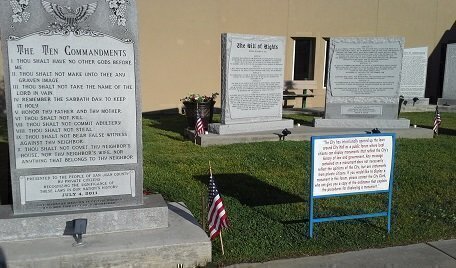Without comment on Monday, the Supreme Court rejected an appeal from a New Mexico town to allow a Ten Commandments monument at its city hall, in a fight between the city and members of the Wicca faith.
 Last summer, Bloomfield, New Mexico and a religious freedom advocacy group, the Alliance Defending Freedom, asked the Court to accept its appeal in a case called City of Bloomfield v. Felix from the federal 10th Circuit Court of Appeals.
Last summer, Bloomfield, New Mexico and a religious freedom advocacy group, the Alliance Defending Freedom, asked the Court to accept its appeal in a case called City of Bloomfield v. Felix from the federal 10th Circuit Court of Appeals.
The debate in Bloomfield goes back to 2007, when a Bloomfield city council member championed the placement of a Ten Commandments monument in front of City Hall. After several years and several regulations, the privately funded monument was erected. In 2011, a disclaimer was placed next to the monument by the now-former councilman, identifying the space as a public forum and inviting petitions from the public for other historical monuments to be placed in the location.
Two members of the Wicca faith then sued the city, claiming the monument violated the First Amendment’s prohibition of a government endorsement of religion. Shortly before the lawsuit was filed, Bloomfield placed a Declaration of Independence monument in the same public forum. And after the lawsuit started, it added Gettysburg Address and Bill of Rights monuments.
In 2014, a United States District Court in New Mexico sided with the Wiccans and the American Civil Liberties Union, which represented them. “The Ten Commandments monument is government speech regulated by the Establishment Clause because the Ten Commandments monument is a permanent object located on government property and it is not part of a designated public forum open to all on equal terms,” said Senior District Judge James A. Parker.
Parker cited a comment made in a 2011 dissent from Justice Clarence Thomas about Establishment Clause cases where Thomas said such “jurisprudence has confounded the lower courts and rendered the constitutionality of displays of religious imagery on government property anyone's guess.”
But Parker said the timing of Bloomfield’s placement of the Ten Commandments monument, its special relationship with the former councilman, and its inability to publicly open the alleged public forum space to "many different historical viewpoints" led to his decision.
On appeal, the three-judge 10th Circuit Appeals panel again sided with the plaintiffs. The full Circuit Appeals decided not to hear the case, but two judges dissented in that decision. Then-federal judge Neil Gorsuch didn’t take part in that February 2017 decision after his nomination to the Supreme Court.
In its petition to the Supreme Court, the Alliance Defending Freedom said it wanted the Supreme Court to settle two questions: the Establishment Clause standard applied to monuments and if someone can sue on First Amendment grounds if they are offended by a monument.
Scott Bomboy is the editor in chief of the National Constitution Center.







